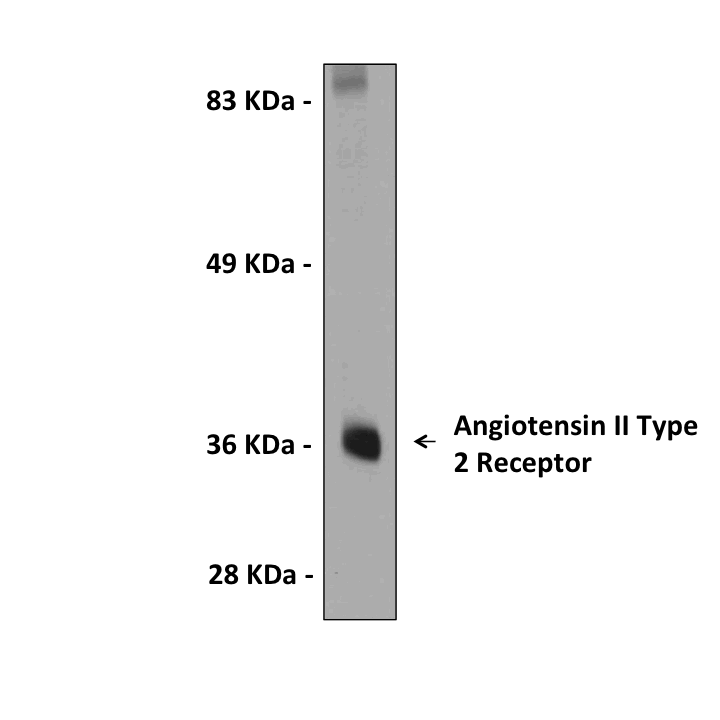Anti-AT2: Rabbit Angiotensin II Type 2 Receptor AT2 Antibody |
 |
BACKGROUND Angiotensin II (Ang II), the major effector of the renin-angiotensin system (RAS), acts mainly via two different receptors: Ang II type 1 (AT1) recep¬tor and Ang II type 2 (AT2) receptor. These two receptors were initially defined on the basis of their differential pharmacological and biochemi¬cal properties, and later cloned. The AT1 receptor mediates most of the well-known effects of Ang II, which include vasoconstriction, cell growth, generation of oxidative stress and inflammation, vascular and cardiac hypertrophy, and stimula¬tion of aldosterone secretion among others. Actions of the AT2 receptor are less clear, but seem to counterbalance some of the actions of the AT1 receptor.1 The AT2 receptor is involved in physiological processes such as development and tissue remodeling (by inhibition of cell growth and stimulation of apoptosis), regulation of blood pressure (BP) (vasodilatation), natriuresis and neuronal activity.2 The AT2 receptor shares 34% sequence homology with its AT1 receptor coun¬terpart, and encodes for a protein of 363 amino acids with a molecular weight of 41 kDa. In humans, the AT1 receptor is widely expressed at relatively constant levels in adults and is localized in numerous tissues, including blood vessels, the heart, kidneys, adrenal glands, liver, and adipose tissue. In contrast, the AT2 receptor is mainly present during fetal development, and is believed to have an essential role in physiological development in general, in part through its action on vascular development. However, the density of the AT2 receptor decreases rapidly after birth in most tissues. In adults, expression of the AT2 receptor under normal conditions is largely restricted to the adrenals, kidneys, uterus, ovary, heart, and specialized nuclei in the brain. Nevertheless, expression of the AT2 receptor is upregulated in various pathological conditions associated with tissue remodeling or inflamma¬tion, including hypertension, atherosclerosis, heart failure, myocardial infarction, tissue ischae¬mia, and in diabetes mellitus. Multiple hormo¬nal and metabolic factors, as well as different cytokines, are involved in upregulation of the density of the AT2 receptor on cells. Conversely, downregulation of the AT2 receptor may be brought about by glucocorticoids and growth factors, and perhaps also by the AT1 receptor.
Both the AT1 and AT2 receptors are members of the G-protein-coupled receptor (GPCR) family and are believed to induce different signaling pathways and cellular responses. The AT1 recep¬tor is implicated in most of the deleterious effects of Ang II in cardiovascular pathophysiology. Because of its potential countervailing effects to the AT1 receptor, activation of the AT2 receptor is believed to have beneficial cardiovascular effects. AT1 receptor antagonists appear to exert their effects on the one hand via blockade of activation of deleterious signaling pathways mediated by the AT1 receptor, and on the other hand, by stimulation of renin release and increased genera¬tion of Ang II which acts on unblocked AT2 recep¬tors. Signaling pathways induced by the stimulation of the AT2 receptor are poorly understood, but three main mechanisms have been described: (a) activation of protein phosphatases causing protein dephosphorylation; (b) activation of bradykinin/nitric oxide/cyclic guanosine 3’, 5’-monophosphate pathway; and(c) stimulation of phospholipase A2 and release of arachidonic acid. Stimulation of the angiotensin II type 2 receptor (AT2) activates SHP-1 and leads to the activation of p38MAPK, NF-kB and inhibition of JNK, ERK1/2 and RhoA through the activation of Ste20-related kinase (SLK). SHP-1 also inhibits the association of the angiotensin II type 1 receptor (AT1) and epidermal growth factor receptor (EGFR), and facilitates the association of the AT2 and the EGFR.3
Both the AT1 and AT2 receptors are members of the G-protein-coupled receptor (GPCR) family and are believed to induce different signaling pathways and cellular responses. The AT1 recep¬tor is implicated in most of the deleterious effects of Ang II in cardiovascular pathophysiology. Because of its potential countervailing effects to the AT1 receptor, activation of the AT2 receptor is believed to have beneficial cardiovascular effects. AT1 receptor antagonists appear to exert their effects on the one hand via blockade of activation of deleterious signaling pathways mediated by the AT1 receptor, and on the other hand, by stimulation of renin release and increased genera¬tion of Ang II which acts on unblocked AT2 recep¬tors. Signaling pathways induced by the stimulation of the AT2 receptor are poorly understood, but three main mechanisms have been described: (a) activation of protein phosphatases causing protein dephosphorylation; (b) activation of bradykinin/nitric oxide/cyclic guanosine 3’, 5’-monophosphate pathway; and(c) stimulation of phospholipase A2 and release of arachidonic acid. Stimulation of the angiotensin II type 2 receptor (AT2) activates SHP-1 and leads to the activation of p38MAPK, NF-kB and inhibition of JNK, ERK1/2 and RhoA through the activation of Ste20-related kinase (SLK). SHP-1 also inhibits the association of the angiotensin II type 1 receptor (AT1) and epidermal growth factor receptor (EGFR), and facilitates the association of the AT2 and the EGFR.3
REFERENCES
1. Horiuchi, M. et al: Hypertension 33:613-21, 1999
2. Ichiki, T. et al: Nature 377:748-50, 2002
3. Lemarié, C.A. & Schiffrin, E.L.:J. Renin-Angiot.-Aldost.11:19-31, 2010
2. Ichiki, T. et al: Nature 377:748-50, 2002
3. Lemarié, C.A. & Schiffrin, E.L.:J. Renin-Angiot.-Aldost.11:19-31, 2010
Products are for research use only. They are not intended for human, animal, or diagnostic applications.
Параметры
Cat.No.: | CG1622 |
Antigen: | AGTR2 antibody was raised against a 16 amino acid peptide from near the center of human AGTR2. |
Isotype: | Rabbit IgG |
Species & predicted species cross- reactivity ( ): | Human, Mouse, Rat |
Applications & Suggested starting dilutions:* | WB 0.5 µg/mL. IP n/d IHC 5 ug/mL ICC n/d FACS n/d |
Predicted Molecular Weight of protein: | 36 kDa |
Specificity/Sensitivity: | Detects endogenous AT2 proteins without cross-reactivity. |
Storage: | Store at -20°C, 4°C for frequent use. Avoid repeated freeze-thaw cycles. |
*Optimal working dilutions must be determined by end user.
Документы
|
| ||||||||||
| ||||||||||
|
| ||||||||||
| ||||||||||
Информация представлена исключительно в ознакомительных целях и ни при каких условиях не является публичной офертой








